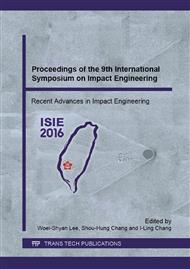p.128
p.133
p.139
p.147
p.153
p.159
p.167
p.174
p.180
Validation of the Hardening Behaviors for Metallic Materials at High Strain Rate and Temperature by Using the Taylor Impact Test
Abstract:
This paper is concerned with the validation of the dynamic hardening behaviors of metallic materials by comparing numerical and experimental results of the Taylor impact tests. Several uniaxial tensile tests are performed at different strain rates and temperatures by using three kinds of materials: 4130 steel (BCC); OFHC copper (FCC); and Ti6Al4V alloy (HCP). Uniaxial material tests are performed at a wide range of strain rates from 10−3 s−1 to 103 s−1. Moreover, tensile tests are performed at temperature of 25 °C and 200 °C at strain rates of 10−3 s−1, 10−1 s−1, and 102 s−1, respectively. A modified Johnson–Cook type thermal softening model is utilized for the accurate application of the thermal softening effect at different strain rates. The hardening behaviors of the three materials are characterized by comparing the seven sequentially deformed shapes of the projectile from numerical and experimental results of Taylor impact tests.
Info:
Periodical:
Pages:
153-158
Citation:
Online since:
September 2016
Authors:
Keywords:
Price:
Сopyright:
© 2016 Trans Tech Publications Ltd. All Rights Reserved
Share:
Citation:


